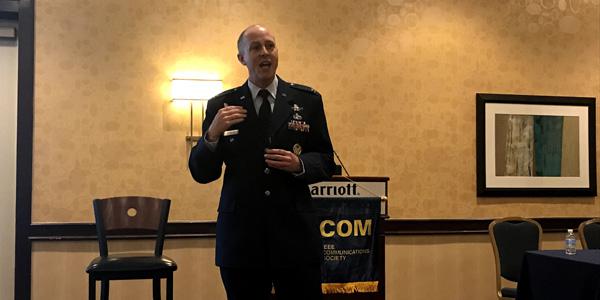Air Force Tells Satellite Industry to Make Room for Flexibility
While the U.S. Air Force will always have purpose-built and single-provider satellite communications, it wants to move into more flexible constructs that would allow warfighters to jump between multiple providers, frequency bands and systems.
“Space, like many other domains, is becoming more contested, more threatened, and we have to take action,” said Col. James Reynolds, USAF, senior materiel leader, Advanced Systems Division, Space Superiority Systems Directorate, Space and Missile Systems Center (SMC). “We can't continue to build our space systems and our space capabilities in the way that we had built them traditionally. We were in a benign environment and could take time, be very risk averse, and make sure that we were getting the precise and exquisite capabilities from our systems. From a warfighter perspective, as long as we had those capabilities and could sustain them, there wasn't really a driving need to accelerate the path and capabilities, but that has changed.”
Air Force leaders as well as industry experts shared their views this week at the MILCOM conference, a military communications forum hosted by AFCEA International and IEEE in Los Angeles, October 29-31.
Part of enabling flexibility means having open architecture standards that will outline development structures. SMC is beginning the process of developing standards.
“These open architecture standards would allow you to then partner with international, with inter-government, with commercial providers, because they’re using the same open architecture standards, so their architectures would fit in with yours,” Col. Reynolds said.
In addition, the standards would widen the field of providers, the colonel said. “[They] would allow you to bring in a lot of nontraditional [providers], while still maintaining the tight connection with our traditional industry partners,” he stated.
The colonel also posits that such standards provide an environment for rapid prototyping. “We would be able to get through that development cycle, that technology, and whatever testing and training is needed to make it operationally useful, faster,” he said. “You can do all that within the same environment instead of having to create multiple environments and go through a serial process. That's really our vision for how we achieve speed and get iterative delivery of capabilities. So it's not just getting faster, but it's also getting repeatable.”
Satellite terminals would be the cornerstone for any flexibility, said Lt. Col. Gary Thompson, USAF, chief, Future Concepts Team, Advanced Concepts Division, MILSATCOM Systems Directorate. Terminals that offer flexibility could help the military avoid vendor lock, he emphasized.
This flexibility would start with the choice of modem, and when different modems are involved, users could access different service providers. Col. Thompson noted that a number of multiband terminals exist, but additional configuration options would allow a choice of providers, which would enable more resilient service from primary, secondary and tertiary satellite communications (SATCOM) paths. These alternatives also would help military SATCOM planners. “We don’t always get to choose where we are deployed, and what SATCOM we’ll have.”
Col. Thompson cautioned, however, that in some instances a terminal should not enable flexibility. “There are times when flexibility won’t work,” he noted, an opinion Mark Dale, director, business development, Kratos-RT Logic, shared. “Flexibility is not the be-all-and-end-all for all terminals,” Dale stated. “Some terminals are not just going to be good candidates for that type of hybrid architecture.”
Eric Hall, senior technical fellow, L3 Technologies, added that a hybrid flexible architecture is important, but integration of components to achieve that could be challenging and costly. “A lot of times the cost of integration is more than the electronics,” he noted. Ease of integration is very important, as are modems, he emphasized.
Hall also raised the point that flexibility in airborne applications may be difficult. “The control systems and the management systems on the aircraft drive that flexibility, and those interfaces are critical for command and control,” he noted. “You can’t just change that.”
Rajeev Gopal, senior technical director, Advanced Systems, Hughes Network Systems LLC, offered that flexibility would not just come from hardware. “A lot of value [in satellite operations] is getting added through software,” he said. “The flexibility will come from algorithms.”
When the U.S Defense Department is turning to hardware to enable flexibility, Gopal suggested, the military should try to harness the benefits of buying in bulk because its purchases are not always as low-priced when purchasing limited quantities compared to commercial customers that acquire more satellite communications technologies.
Kurt Fiscko, technical director, Navy Program Executive Office for Command, Control, Communications, Computers and Intelligence (C4I), Space and Naval Warfare Systems Command (SPAWAR), stressed that for the Navy, it’s a problem if flexibility in SATCOM is at odds with the service's classified concept of operations. Fiscko also observed that installation of new modems to enable flexibility is no small endeavor. “To put a new modem in a fleet, which could total more than 1,000 modems, could mean a bill of $100 million and take three years,” he noted, “and that is with commercial off-the-shelf technology.”
As such, SPAWAR is looking for “an evolutionary approach to terminal flexibility,” as well as a joint program office to manage any standards. “We do support the idea of flexible terminals,” he stated. “We are here to play, but we don’t want to lead the way.”
However momentous the drive to flexible satellite architecture may be, the Defense Department does need to act or the military will be stuck in a stovepiped and expensive special-purpose build environment, Col. Thompson warned. “If we take a wait-and-see attitude, and we are not driving toward flexibility, then some of our SATCOM choices will be made for us,” he stated.




Comments